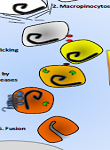|
|
|
The Ebola virus journey into the host cell
|
|
|
|
|
|
|
|
|
|

|
|
|
Marceline Côté
|
|
|
|
Brigham and Women’s Hospital and Harvard Medical School
|
Medicine, Hematology Division, BWH and Harvard Medical School, Boston, MA 02115, USA.
|
|
mcote3@partners.org
|
|
|
|
|
|
|
|
|
|

|
Ebola and Marburg filoviruses are enveloped viruses causing severe hemorrhagic fevers in humans and non-human primates. To date, there is no vaccine or effective antiviral therapy against these highly pathogenic viruses. The development of new drugs highly depends on the elucidation of the entire life cycle of the virus. Virus entry in the host cell is the first step of infection as it allows the virus to deliver its genome into the cell cytoplasm and initiate replication. Although only one viral protein, the viral glycoprotein (GP), is responsible for tropism and fusion of the viral membrane with the cell membrane, virus entry is far more complex than it seems. Upon infection, GP interacts with a multitude of cellular proteins to adhere to the host cell surface and promote the internalization of the virus particle in intracellular vesicles. The virus is then transported and trafficked in order to gain access to specific cellular compartments containing proteins necessary for the activation of the GP fusion activity. The catalysis of the fusion of the viral membrane with the cellular membrane represents the final step in entry and the beginning of virus replication. In recent years,.....
|
|
|
|
|
|
|
|

|
|